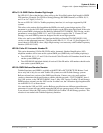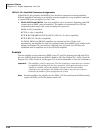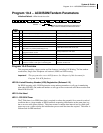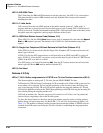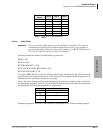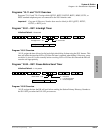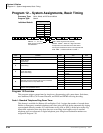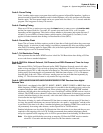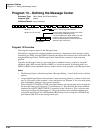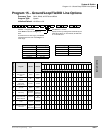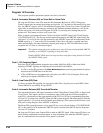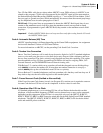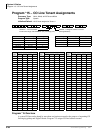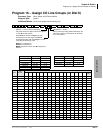
System & Station
Program 12 – System Assignments, Basic Timing
Strata DK Programming 5/00 3-45
System & Station
Code 3: Pause Timing
Code 3 enables station users to program short and long pauses in Speed Dial numbers. Applies to
pauses inserted in Speed Dial numbers used for both telephone voice calls and data calls from data
interface units. The short pause length can be set system wide for either 1.5 or 3 seconds with this
program. The long pause is always 10 seconds.
Code 4: Flashing Timing
When on a CO line, a station user can press the
)ODVK button (or enter access code &QI7UQ)
and the line opens (flash) for 2 seconds, 0.2 seconds (not used in the USA), or 0.5 seconds
depending on this assignment. This choice reflects whether to disconnect and regain dial tone (2
seconds), or to use PBX or Centrex features which require a flash signal (0.5 seconds). It also
applies to flashes inserted when dialing via Data Interface Units (DIUs).
Code 5: Pause After Flash
Some COs or Centrex facilities require a period of time after a flash signal before they can accept
dialing signals. A selection of pause timing is available to automatically delay any dialing signals
after flash. This timing applies to Speed Dial calls (with flash signals between the telephone
number digits) as well as to manual dialing.
Code 7: Toll Restriction Timing
This represents the time that a DTMF receiver is held for Toll Restriction after dialing a CO line
access code from a standard telephone.
Code 8: DNIS Ext. Network External, Call Forward, and DISA Disconnect Timer for Loop
Start LInes
Disconnects DISA, Call Forward External and/or DNIS Telephone Network routed calls when
made on loop start lines. Calls can lock-up (keep busy indefinitely) if the CO does not send a
disconnect signal (CPC or AR) when the caller hangs up. This timer prevents loop start lines from
locking up by disconnecting the call automatically when the timer expires, 4, 10, or 20 minutes
from the start of the call. Callers will hear a warning tone and can reset the timer repeatedly by
dialing “0”. This disconnect feature is only needed for loop start lines.
Code 9: QRCU3/K4RCU3/K5RCU/K5RCU2/RRCS/BRCS DTMF Receiver Inter-digital
Release Time
With Code 9, one channel of the QRCU3, K4RCU, K5RCU, K5RCU2, RRCS or BRCS Dual-tone
Multi-frequency (DTMF) receiver is seized when it is needed for the decoding process, such as for
a standard telephone with a DTMF dial pad. When placing outgoing calls with DTMF standard
telephones, the talk path to the outside party is not “cut-through” until the DTMF receiver circuit is
released. The DTMF receiver channel’s release time can be programmed for between one and nine
seconds (initialized timing is four seconds)—this is the time it takes to release the DTMF receiver
circuit after the last digit is dialed.
The choice of timing is a trade-off between CO line time to connect and user speed. If the time is
too long, the outside called party may answer before the voice path is “cut-through,” and the caller
is not heard. If the time is too short, a standard telephone user inputting DTMF tones could be cut
off prematurely from using other features, such as Speed Dial or Toll Restriction.
Standard telephones can also defeat Toll Restriction if the seize time is too short and they are not
required to dial outgoing calls via LCR. Toshiba recommends that standard telephones should
always be required to dial outgoing calls via LCR to prevent them from defeating Toll Restriction.
Note If no digits are dialed after accessing an outgoing CO line, the DTMF receiver remains
seized for 15 seconds and then drops; however, the line remains connected.



